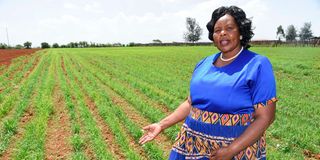Why farmers want State to use cooperatives for cheap fertiliser

Prisca Keter, a farmer in Kabobo in Soy Constituency, Uasin Gishu County shows her millet crop on May 21, 2022. She said the high cost of fertiliser has affected acreage per crop in her farm.
What you need to know:
- In the North and South Rift regions, farmers told Nation.Africa that they had not received the cheap fertiliser
- KFA says a proper database of farmers needs to be set up to ensure that only genuine ones benefit from the government fertiliser subsidy programme
- Last season, most farmers failed to get affordable fertiliser, with government officials citing a global shortage of the commodity
Farmers want the government to use cooperative societies to distribute subsidised fertiliser promised to farmers so as to lock out brokers.
At his inauguration last week, President William Ruto announced plans to distribute 1.4 million bags of fertiliser at a reduced price of Sh3,500 per 50kg bag, down from Sh6,500, as part of interventions to increase food production and bring down the cost of living.
Kenya Farmers Association (KFA) director Kipkorir Menjo said cooperatives will ensure many small-holder farmers get cheap fertiliser.
“If the process is well managed, the fertiliser will reach most of the small-scale farmers. However, this should not be restricted to cooperatives only. [Community-based organisations] and other groups can also be used as long as they are legally registered and allowed to distribute the fertiliser,” Me Menjo explained.
No fertiliser
In the North and South Rift regions, farmers told Nation.Africa that they had not received the cheap fertiliser.
“We have received fertiliser through Kenya Tea Development Agency (KTDA) which has been deducted through the organisation. However, we expect the cheap fertiliser in the coming weeks as directed by President Ruto,” said Peter Sigei, a tea farmer in Bomet County.
For the past two weeks, some tea farmers have received fertiliser for Sh5,600 per 50kg bag from KTDA under an earlier deal with the agency.
Dairy farmers are grappling with the high cost of animal feed in the market due to rising costs of raw materials even as they hope to get fertiliser to grow fodder.
“We want to urge the government to use cooperatives so that the fertiliser can get to all wards. We want to take advantage of the good rains expected from next month to grow pasture for our livestock,” said David Chobet, who practises mixed farming.
Proper database
He said affordable fertiliser will enable farmers to plant high-value crops and fodder for their livestock.
Mr Menjo said a proper database of farmers needs to be set up to ensure that only genuine ones benefit from the government fertiliser subsidy programme.
“We have been told that the database is still in the pilot stage. But there is a need to do proper registration of farmers to ensure that the process is not abused,” said the official.
Kenya’s maize production has fluctuated in the past eight years, with the highest yields reported in 2018 (44.6 million bags) and the lowest in 2017 (35.4 million).
Farmers produced 40.7 million bags in 2013, 39 million in 2014, 42.5 million in 2015, 37.8 million in 2016, and 39.8 million in 2019, according to the Kenya National Bureau of Statistics.
Several factors – including erratic rainfall, high costs of farm inputs, disease outbreaks such as armyworms, head smut and maize lethal necrosis – have contributed to the decline in maize yields.
Global shortage
Last season, most farmers failed to get affordable fertiliser, with government officials citing a global shortage of the commodity.
Trans Nzoia Agriculture executive Dr Mary Nzomo said maize production in the region this year is forecast to stand at 5.27 million 90kg bags against a target of 5.6 million.
She attributed the decline to non-optimal use of fertiliser during planting due to high production costs.
“Most farmers did not achieve the optimal application rates and this will definitely lead to low productivity,” she told Nation.Africa.





